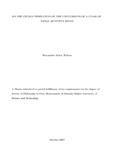ON THE CHARACTERIZATION OF THE UNIT GROUPS OF A CLASS OF TOTAL QUOTIENT RINGS
Abstract
Let R be a completely primary finite ring of characteristic pk, where p is a prime and k is a positive integer. Such finite rings have been studied extensively in recent years and the tools necessary for describing completely primary finite rings have been available for some time. However, their characterization is not exhaustive. Several attempts have been made in the recent past in the characterization of the unit groups of this class of rings though not in general. The characterization of a finite abelian group is precisely known and from the fundamental theorem of finitely generated abelian groups, it has been represented as a direct product of cyclic groups. If R is a finite field then U(R) the unit group of R is cyclic. Suppose S is a saturated multiplicative subset of R so that RS is a total quotient ring of R obtained
by the localization of R at the maximal ideal J(R): Since R is local, then R =
RS: We have characterized the unit groups of RS; denoted U(RS) as U(RS) = Zpr1 11 + J(RS) by determining the generators of the group 11 + J(RS): The methods used include construction of RS using the method of idealization, proofs and veri cation of the proposed statements and claims. The results obtained, provide an alternative understanding of the structures of unit groups of these classes of finite rings and provides a partial solution to the problem of
isomorphic rings with similar groups of units. This results also nd practical applications in various felds including Computer Algebra and forms and structure of elements in chemistry.

